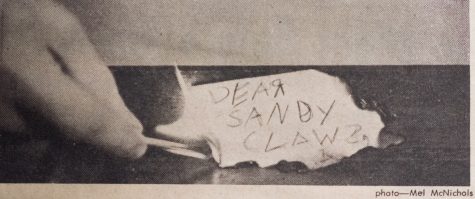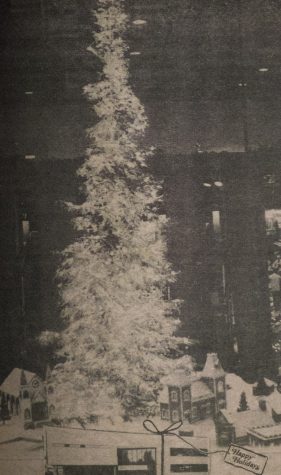Modern Christmas grows from commercial iconography
December 4, 2019

A photo illustration from the 1967 Christmas Special Edition of The Falcon, which ran with an article entitled ‘To Santa Claus:’-Return to Sender.
Christmas in the United States is known for a set of seemingly “universal” and timeless traditions, but the history of these traditions is more varied and complex than one might expect.
Santa Claus himself, arguably the holiday’s most emblematic figure, originated in the story of Saint Nicholas. According to National Geographic, Saint Nicholas of Myra, who is said to have been born in what is now known as Turkey near the year 280 A.D., was known as a figure of protection and kindness, especially to children.
He earned this reputation via several well-known legends associated with him, such as saving three sisters by paying their dowries. He was believed to have given away all of his wealth and traveled to serve the sick and impoverished, and was widely associated with piety and compassion.
Saint Nicholas died on Dec. 6 in the mid 14th century, and the date came to be celebrated as his feast day to those who followed him.
The sixth remained the principal day of celebration in association with Saint Nicholas for many years, as Christmas Day was not named the 25th of December until Pope Julius I chose the day to celebrate Jesus’s birth.
According to editors at history.com in their article “History of Christmas,” “It is commonly believed that the church chose this date in an effort to adopt and absorb the traditions of the pagan Saturnalia festival.”
The Saturnalia festival was a Roman celebration during the week leading up to the winter solstice, honoring Saturn, the god of agriculture. They also celebrated Rome’s children in Juvenalia during this time, and some upper class Romans celebrated the sun god Mirtha’s birthday on Dec. 25.
Once established, Christmas Day came to be connected to Saint Nicholas due to the proximity of their celebrations, and the reputation of Nicholas being protector and gift-bearer to children. The article specifies that continued celebrations of Saint Nicholas’s feast day by Germanic peoples helped to popularize the figure across continents.
However, even then, this version of Saint Nick looked nothing like the Santa known today — he was much more elvish, often thin and notoriously harsh toward naughty children — nor did he yet have much of the lore that is associated with him today. Those came via American poets and writers in the 1800s.
According to National Geographic, “Washington Irving’s 1809 book “Knickerbocker’s History of New York” first portrayed a pipe-smoking Nicholas soaring over the rooftops in a flying wagon, delivering presents to good girls and boys and switches to bad ones.”
“The Children’s Friend,” an anonymous illustrated poem published in 1821, further crafted the image now associated with Santa Claus and linked him to the Christmas holiday. This poem was highly influential to the modern perception of Santa.
“Here we finally have the appearance of a Santa Claus,” University of Manitoba historian Gerry Bowler, author of “Santa Claus: A Biography,” said for National Geographic. “They’ve taken the magical gift-bringing of St. Nicholas, stripped him of any religious characteristics, and dressed this Santa in the furs of those shaggy Germanic gift bringers.”
The final piece of this formation was the work that we now know as “The Night Before Christmas,” which was originally written as “A Visit From St. Nicholas” by Clement Clarke Moore in 1822. He wrote the work for his six children, but it was anonymously published the next year and has, since, drastically shaped American Christmas tradition.
In 1931, the Coca-Cola company began placing holiday advertisements in magazines. It was decided that a wholesome, family-friendly version of Santa Claus was needed — so the company commissioned illustrator Haddon Sundblom to create images of a personable, marketable Santa Claus.
Sundblom turned to “A Visit From St. Nicholas.” According to the Coca-Cola website, “Moore’s description of St. Nick led to an image of a warm, friendly, pleasantly plump and human Santa.” This image gained traction in the U.S., and is what we now know as modern Santa Claus.
“Sundblom’s Santa debuted in 1931 in Coke ads in ‘The Saturday Evening Post’ and appeared regularly in that magazine, as well as in ‘Ladies Home Journal,’ ‘National Geographic,’ ‘The New Yorker’ and others,” according to the authors, “conversations staff” at the company.
Once established in the U.S., the new legend then made its way back across the pond to Europe, where the friendlier Santa Claus quickly took root with names like Père Noël in France, or Father Christmas in Great Britain.

As far as other well known traditions, such as Christmas trees, history.com specifies that these originated in winter solstice celebrations throughout the northern hemisphere prior to the arrival of Christianity. The shortest days of the year were often celebrated as a return of the strength of sun gods, and festivities incorporated evergreen plants.
In regard to our current conception of Christmas trees, German Christians are credited for first bringing trees into their homes, or sometimes building and decorating pyramids of wood if trees were hard to come by.
For decorations, Martin Luther is widely believed to have originated the tradition of Christmas lights.
“Walking toward his home one winter evening, composing a sermon, he was awed by the brilliance of stars twinkling amidst evergreens. To recapture the scene for his family, he erected a tree in the main room and wired its branches with lighted candles,” wrote editors at history.com.
The more commercialized traditions that are now associated with Christmas have not always been perceived the way they are now, and their more complex origins are often unexpected.

























































































